I’d like to describe how the Single Transferable Vote (multi-winner Ranked Choice Voting) serves the idea of representative politics. In particular, I’m going to describe how
- every voter can have an equitable share of power,
- candidates are responsive to the voters that put them in power, and
- candidates can work together on campaigns,
This differs from our current district-based single-winner single-choice voting method, where
- voters often feel their vote is wasted, and
- candidates are antagonistic towards each other during campaigns.
I’m also going to describe other mechanically similar voting methods that achieve the same goals.
Representative Politics
Representation is a very fundamental concept to government. The idea of a body of representatives is to try to represent a diversity of interests as a team, and each member of the team would be responsive to the voters that put them in power. The goal is representation of minorities so that any member of the community can have an equitable share of power. This is more representative than having one single person to represent everyone, such as a president.
Voting districts are used to give representation to voters that live in a geographical area. For example, you could have each state elect representatives to a national body. Here’s an interactive simulation of districts: (as a side point, candidates from different districts don’t have to fight each other. At least, not until they get elected and start arguing about legislation.)
District Representation
Each district gets a representative, and we use choose-only-one voting within each district.
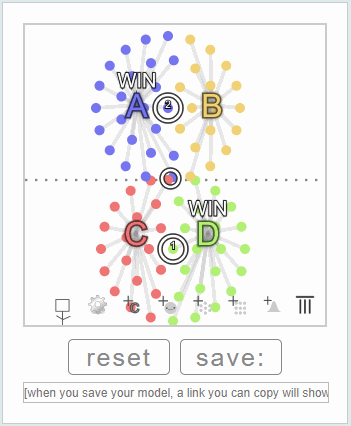
In the same way, representation can be given to voters that are from different political spaces. This idea is called proportional representation because the number of representatives is proportional to how many voters are in a political space. It’s more representative than districts for reasons we will go over later on this page.
Proportional Representation
Each center of political thought gets a representative. We use two-winner Ranked Choice Voting.

The key advantage of STV is that districts do not need to be drawn around political minority groups in order to give them representation. Just look at how in a complex opinion-space, there is an evenly distributed selection of winning candidates:
Evenly Distributed Representation
With five representatives, STV can spread them out to be closer to the voters. (Dots are used for voters and circles show candidate totals, including transferred votes from eliminated candidates.)
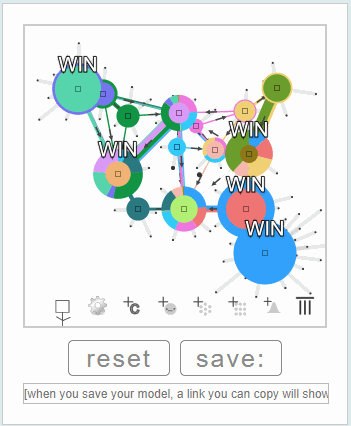
Kinder Political Culture
STV allows multiple factions within a party to be represented, so these factions don’t have to feel threatened by each other, which would allow them to work better together. Small groups can form to support an idea, and supporters don’t have to face a dilemma of whether they’re going to support an idea that they like best or support an idea that is more likely to be accepted by many other people. This is easier for the voters because the voters can use the voting method to find common ground rather than trying to use polls to figure out which candidate to unite behind. The voters can be more honest, and the campaigns can be more honest.
Still, some things won’t change. There will still be disagreements in the legislature once candidates are seated. I think it’s more acceptable to expect compromises and cooperative trading of policy favors in a legislature rather than at the time of an election where voters would have to sift through any misinformative campaign techniques. Legislators are more able to form cooperative relationships than groups of voters, so we are designing a system that works better for representing people, and it should lift a lot of burden off the voters’ shoulders.
Equality
In both district representation and in proportional representation, there is a standard of equality among voters.
For districts, you have a district size, which is the number of people in a district. For proportional representation, you have a quota size, which is the number of people represented by a winning candidate. Basically, it’s how widely supported an idea needs to be in order to get a representative at the table.
In a way, the idea of a quota size already applies within a single-winner district, and it’s about 50%. It can be higher, and it can be lower. Someone can win with 48% if nobody else did better. Or 28%, which actually happens in crowded races. If only 28% voted for the winner, then that means 72% of voters might not be represented until the next election.
Single-Winner Single-Choice: 28% Wins
If you only say, "pick only one", then the winner can win with only a small part of the votes.
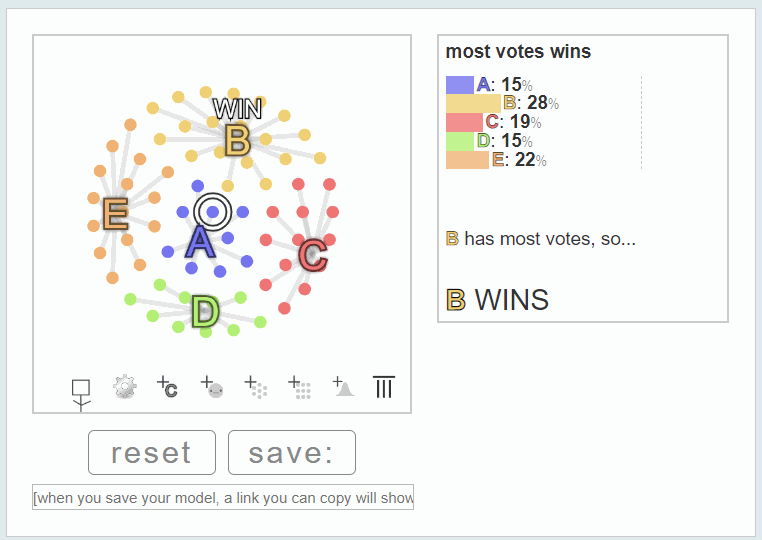
If you use single-winner Ranked Choice Voting, then the quota is 50%. The ballot counts for the top choice, so there is no way that there is another candidate with more than 50% of ballots who could win. So, in the final round, between the last two contenders, more than 50% of people who had a preference between the two got their preferred candidate. In that sense, more than 50% of people are represented because their votes mattered in deciding the outcome.
Refresher on RCV: Ranked choice voting asks voters to rank the candidates in order from best to worst. During counting, your vote counts for your top candidate. One-by-one, the candidate with the least number of votes is eliminated and taken out of the running. Check out the sketch below that shows everyone connected to their first pick. Colored flow lines show some voters moving to their next choice after their top pick is eliminated. The flow diagram shown on the right is called a Sankey diagram.
(That’s enough of a refresher on RCV to get you through this page, but after you’re done on this page, read this other page on single-winner RCV. )
Single-Winner RCV (IRV)
A candidate needs 50% to win.
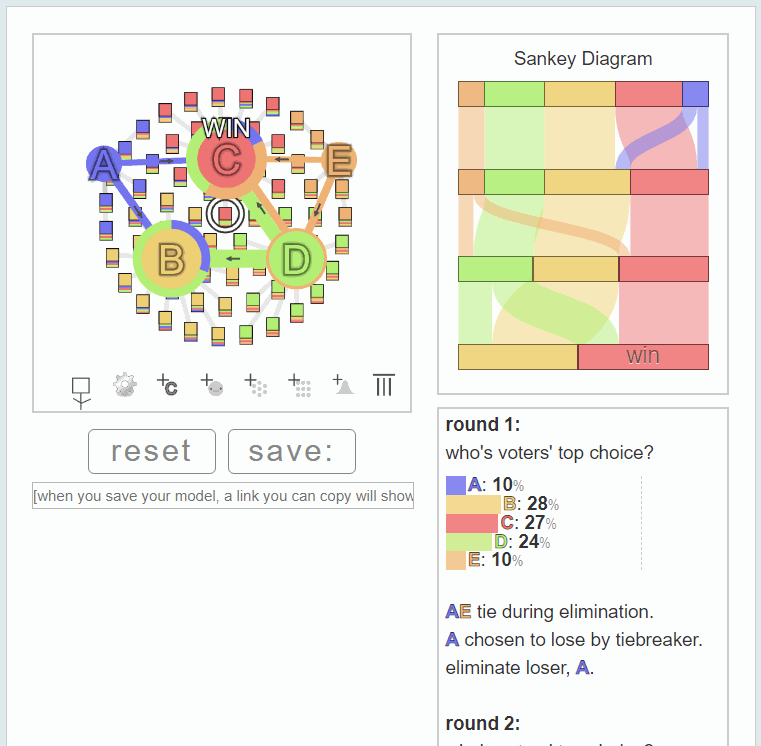
We can extend this logic to quotas for multi-winner Ranked Choice Voting. You wouldn’t be able to elect more than one candidate with a quota at 50%. Mathematically, it is the smallest quota where you can’t elect more than one. So let’s consider two candidates; 33% is the smallest quota where you can’t elect more than two. For three candidates, it’s 25%, and for a number n of candidates, the smallest quota where you can’t elect n+1 is 1/(n+1).
Quota Table
| Number of Winners | Quota | People Represented |
|---|---|---|
| 1 | 50 % | > 50 % |
| 2 | 33 % | > 66 % |
| 3 | 25 % | > 75 % |
| 4 | 20 % | > 80 % |
| 5 | 17 % | > 83 % |
| n | 1/(n+1) | > n/(n+1) |
Three Winners
Each of three groups is able to be represented.

Ranked-Choice Voting is better (more representative) when it allows smaller groups to be represented. Five would be a great number. More would be even more representative but could be overwhelming. Voters don’t have to rank all the candidates. They just need to rank enough to get one candidate elected, or maybe two.
Before we move on, let’s revisit this idea of representation with a few tangent ideas that we’ll only discuss briefly. Like we said before, in the final round, between the last two contenders, more than 50% of people who had a preference between the two got their preferred candidate. In that sense, more than 50% of people are represented because their votes mattered in deciding the outcome. Let’s dive into a little more detail.
Tangent 1: Which supporters does a candidate represent? Which supporters could affect the outcome? Maybe candidates don’t have to pay much attention to their most ardent supporters because their vote is guaranteed. The voters that really matter to them in this model are “swing voters” because those could go either way. In that case, STV is pretty good because there are many boundaries between candidates where voters can swing either way, so more voters matter to the outcome.
Tangent 2: In another sense, the only position the candidate represents is their own. In that case, STV is still pretty good because there are more positions represented and voters have a candidate with a closer position to their own.
Tangent 3: I didn’t model voter engagement, but there is a point to be made here, and it’s where I think an improvement could be made to this model. Disengaged voters are on a candidate’s side but they don’t vote because it takes time and effort. One way I could model engagement is to figure that the closer a voter’s position is to a candidate, the more engaged that voter will be. In that case, having more candidates will lead to greater voter engagement. That is a key feature of voting methods where voters can give their opinion on many candidates, like STV.
Counting Ballots
The fundamental part of what makes STV work is that it counts quotas exactly once.
Once a candidate has been elected by a quota of voters, the voters have successfully used their ballot to get representation, so it is not counted again for a second candidate.
This is kind of like how in districts, you only vote in one district.
This counting method is important because it is what allows small groups to come together to get representation and to not see each other as competing factions.
Visualization
See the example chart below for a visual of the process of elimination. It starts at the top and each row tracks who the voter’s top pick is. Each column is a voter. Transparency is used to represent the excess vote that remains after a quota is filled. As candidates are eliminated, the groups of voters become visually apparent.
Also, notice that the choice of quota size makes sense because 50% of remaining votes are required to elect the final candidate.
Voter Chart By Round
See the chart at the bottom for a visualization of where votes were counted towards a candidate's victory. Mouse over the rounds to see how the chart progresses through the rounds.
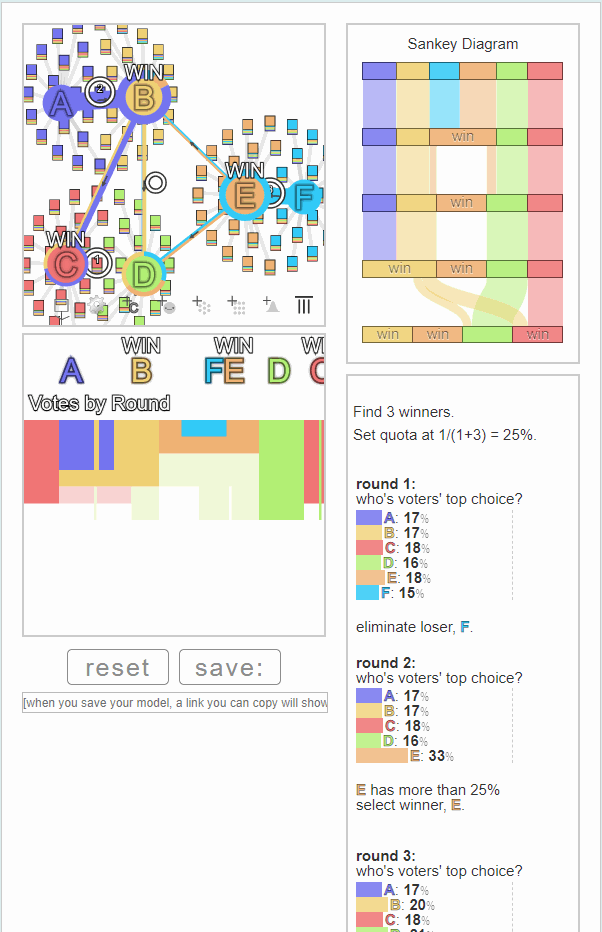
Below this chart are a couple of charts that are a measure of voter power. They track the weight of the each voter’s contribution to a candidate’s election. When a candidate is elected in a round, the voters whose vote counted for that candidate are added to fill up the chart. The intuition is that the voter could have voted for someone else, so the candidate owes them some share of their power.
In the first chart of the “Voter Weighting Used by the Method”, the exact weights used by the voting method to select winners in each round are shown. To choose the final winner, the election is similar to a single-winner election. All that the last guy needs to win is 50% of the remaining vote weight. In the background is a dark bar with a height that corresponds to a vote at its full weight. As candidates get elected, the bar is covered. Any part of the bar that is still showing after all candidates are elected shows votes that are still not counted.
In the second chart of the “Voter Weight Contributed to Candidates”, the total weight given to each candidate is rescaled so that it is equal for each candidate and sums across candidates to the full amount of representation available. In the background is a dark bar with a height that corresponds to every voter contributing equally to the election of the candidates. The height of this bar is each voter’s ideal share of representation.
(Also, here are a few more specifics about these charts. The voters and candidates are arranged in a line by using an algorithm that solves the traveling salesman problem to keep voters together who are near each other in 2D space. Specifically, the ballots are used as coordinates or feature vectors since this 2D space isn’t something you’d be able to see in an election.)
Weight Charts
See the chart at the bottom for a visualization of where votes were counted towards a candidate's victory. Click through the rounds to see how the chart progresses through the rounds.

Voter Power
Voter weight contributed to candidates is not exactly voter power. Power is a collective phenomenon.
Think of single-winner voting methods. The winner is most representative of the median of the group. The median is a collective measure. If there are two sides and both are competing for the median, then both sides are represented. To see why this is the case, consider a case where the election is not competitive and the median belongs to only one side, then all the voters on that side benefit from that power, which is not very representative. The most representative election would be a competitive election where the median could be on either side.
In STV, there are multiple “medians” (more like percentiles), one for each winner. These medians can be spread out over a larger region than for the single-winner case. This means there are more ways to be part of a group that wins, and there are more “swing voters” that could belong to one group or another. Both of these effects mean candidates have to pay attention to more voters.
Also, consider what would happen if, after the election, a candidate shifted their position toward the center of the group that elected them. They would lose the more moderate voters that voted for them when the next election comes.
Quota Excess
What happens if a candidate gets more votes than just a quota? The rule is that exactly a quota of votes is used up by the winner, which means the excess number of votes above the quota remains in the count. These votes will count in proportion to that excess amount. It’s a calculation of dividing the excess by the quota to find the new weight for the vote. This bookkeeping makes sure that the power each voter gets from their vote is the same. It makes sure that all voters are as equal as possible.
Proportionality
Let’s get back to the idea of proportionality. You can see that in STV, a voter group with two times as many voters gets two times as many representatives.
Quotas Give Proportional Results
Here's two groups with a 1:2 ratio (really 4:7). The winners are also in the same ratio.
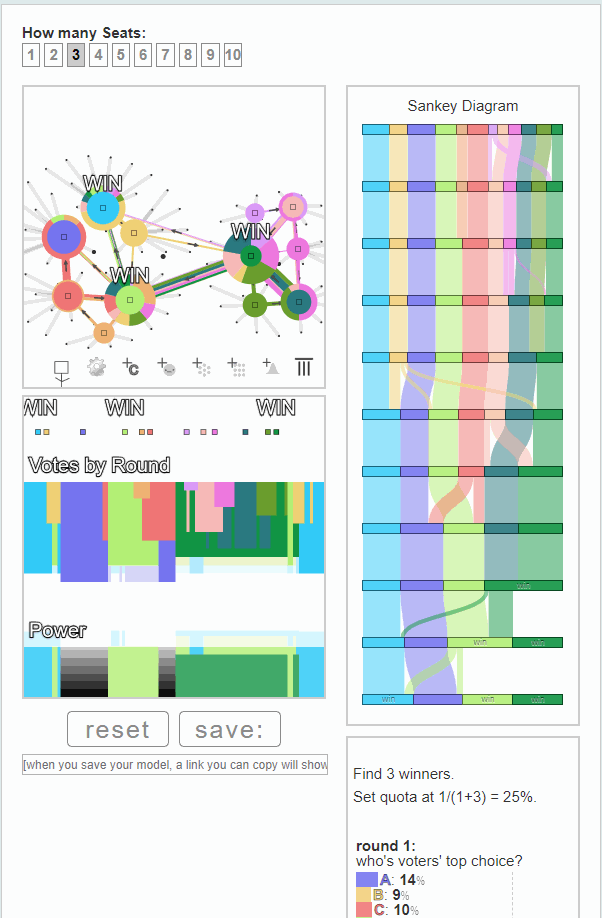
This proportionality applies even when there aren’t distinct groups. Let’s look again at the example we saw earlier, but now using the additional charts.
Evenly Distributed Representation - Again - With Charts
With five representatives, STV can spread them out to be closer to the voters. (Dots are used for voters and circles show candidate totals, including transferred votes from eliminated candidates.)
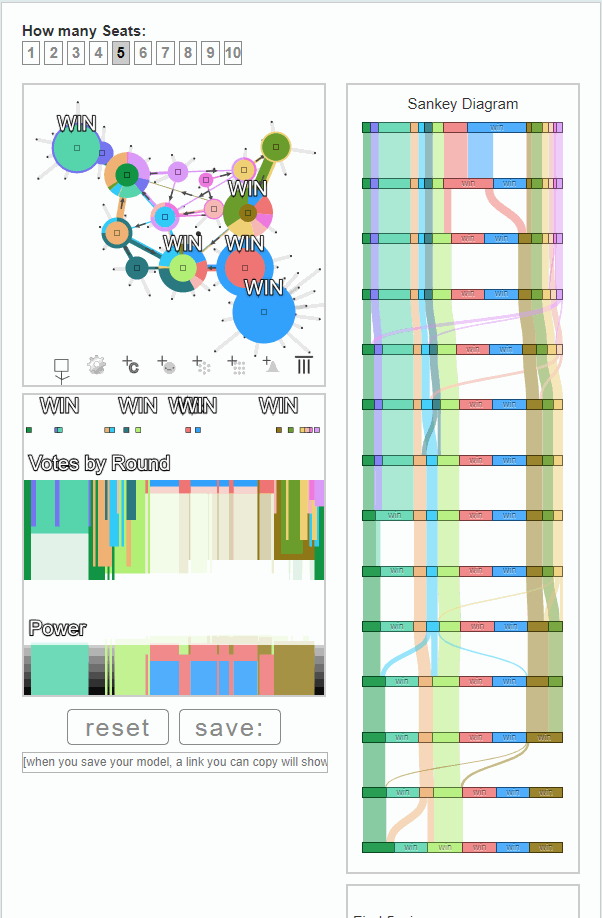
Proportional Methods without Parties
There are more voting methods that use a similar way of assigning voters to STV to achieve proportionality. After you’re done with this page, read more about all the different kinds of proportional voting methods:
Footnotes
Party Proportional Methods
Additionally, there are ways to have proportionality by using a party system, but that is a mechanically-different method that I haven’t added to the simulator yet, so we’ll discuss it on another page to come in the near future.
Strategies
I still need to work out what the strategies would be for voters and candidates. So far, in the above examples, I’ve been using the honest strategy for ranking.
Afterword
The main drive for STV is to have representation of all diverse groups and to include minorities. Group bargaining in this representative group would ideally be able to offer a policy package that includes a little bit from everyone at the table. This is also a vision of a more responsive politics. We don’t have to wait until the election. We can represent each sector of the population today, so that when an event occurs, action can be taken. Also, proportional representation is a further way to avoid antagonistic campaigns. It won’t get rid of partisanship, but it might prevent it from being broadcast to the voters . We can change the political culture and have campaigns that are capable of bringing groups together to achieve a greater goal.
SANDBOX MODE! (link to just this)
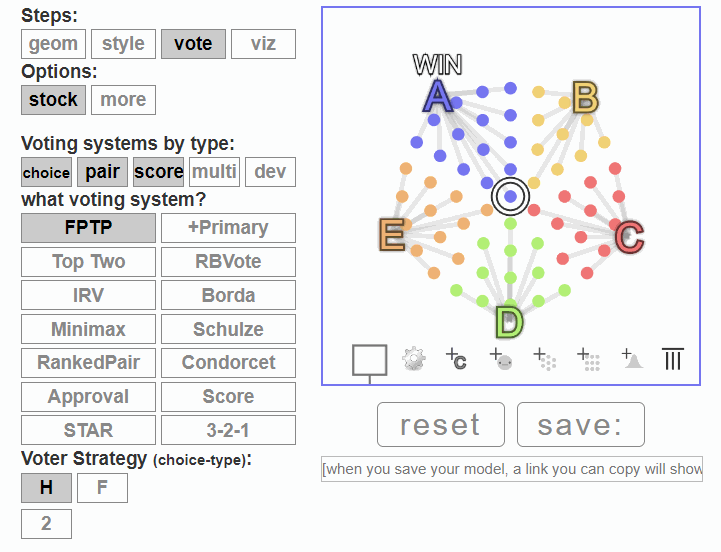
From Nicky Case: One hope for Sandbox Mode is that readers can debate with me and each other using this tool! Not just telling me I'm wrong, but showing me I'm wrong. Granted, this tool is very limited – it doesn't handle strategic voting or imperfect information – but I think it's a start, and may help improve our Democratic Discourse™
From Paretoman: if you'd like your own models included here, save it, copy the saved link, and tweet it with the hashtag #smartvotesim.